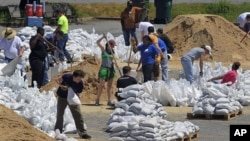The swollen waters of the Mississippi River and its tributaries are forcing thousands of people from their homes in the midwestern and southern United States. Record water levels have caused problems in large areas along the rivers. The United States Army Corps of Engineers is fighting to control the flooding, which could last several more weeks.
Bob Anderson says there is one simple way to describe the flooding along the Ohio and Mississippi rivers this year.
"It’s the record flood," he said.
Anderson is a spokesman for the U.S. Army Corps of Engineers, which is fighting the floodwaters by managing a system of levees along the rivers.
"At certain locations in the watershed we had 600 percent greater than normal rainfall, and that’s one of the main reasons we are seeing such historic flood levels," he said. "Also, the fact is we had a tremendous amount of snow over the winter and all that started melting about the same time all this rain started falling a few weeks ago."
Cairo, situated where the Mississippi and Ohio rivers meet at the southern tip of the state of Illinois, was a target at the center of the floods. About 2,800 people were evacuated when floodwaters threatened to inundate the town.
To save Cairo, the Corps of Engineers blew up an earthen levee on the Mississippi River, intentionally flooding farmland in the neighboring state of Missouri. The Missouri Farm Bureau estimates the cost of the damage to farmland will exceed $100 million.
Corps Spokesperson Bob Anderson says farming is not the only industry affected in the region.
"Many hundreds of people are out of work now because they can’t get to their industries or their companies on the river," he said. "The casino industry is shut down, which is a huge tax base for the state. They are shutting navigation down today because the river is so high on the levees."
As cities further down river brace for approaching floodwaters, Anderson says the crisis could last several more weeks.
"It doesn’t look like it will be until the very end of May, when the final crest that’s predicted by the National Weather Service starts to pass New Orleans," he said.
Many of the states affected by powerful tornadoes in recent weeks, such as Alabama and Tennessee, are now dealing with the prospect of potential flooding.
Floods Force Evacuations Along US Waterways









